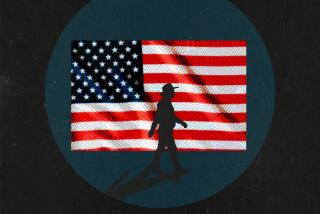How DJs Put 500,000 Marchers in Motion
He’s one of the hottest Spanish-language radio personalities in the nation. So when Los Angeles deejay Eddie Sotelo joined hands with his radio rivals to urge listeners to turn out for a pro-immigrant rally in downtown Los Angeles on Saturday, organizers hoped for a big turnout.
But many said Monday that they were stunned by how many responded to the call to march against federal legislation that would crack down on undocumented immigrants and penalize those who assist them.
For the record:
12:00 a.m. March 30, 2006 For The Record
Los Angeles Times Thursday March 30, 2006 Home Edition Main News Part A Page 2 National Desk 2 inches; 68 words Type of Material: Correction
Protest march: A story in Tuesday’s Section A about the organizers of Saturday’s march in downtown Los Angeles may have implied that a committee appointed by Los Angeles Cardinal Roger M. Mahony to promote the U.S. bishops’ “Justice for Immigrants” campaign and a coalition of religious, community and civil rights activists were identical. Mahony’s committee and the coalition are separate groups, although some activists are members of both.
As a result, what was initially expected to draw fewer than 20,000 ballooned into a massive march that police estimated at 500,000 and said was one of the largest demonstrations in Los Angeles’ history. The march topped a wave of protests drawing hundreds of thousands of participants in cities around the nation, which organizers said influenced the U.S. Senate Judiciary Committee’s approval Monday of legislation that includes legalization for undocumented immigrants.
Rally supporters, including immigrant-rights activists, churches, and labor and community groups, agreed that the active advocacy of the region’s top Spanish-language radio personalities was critical in drawing the enormous crowds, who marched more than 20 blocks along Spring and Main streets and Broadway to City Hall, wearing white “peace” shirts and waving American and Mexican flags.
The promoters included such on-air celebrities as KHJ’s Humberto Luna, KBUE’s Ricardo “El Mandril” (The Baboon) Sanchez, Renan “El Cucuy” (The Boogeyman) Almendarez Coello -- whose often risque show has cast him as a sort of Latino version of Howard Stern -- and Sotelo, better known to listeners as “El Piolin,” or Tweety Bird. Coello’s and Sotelo’s morning talk shows are among the highest-rated programs in any language in Los Angeles.
“They were the key to getting so many people out,” said Mike Garcia, president of Local 1877 of the Service Employees International Union. “If you listened to Spanish-language media, they were just pumping, pumping, pumping this up.”
For his part, Sotelo said he decided to promote the cause -- by calling a summit of his rival deejays to encourage them to do the same -- after rally organizers told him about the ramifications of the legislation passed by the U.S. House of Representatives last December. The bill, by Rep. F. James Sensenbrenner Jr. (R-Wis.), would make undocumented immigrants and those who assist them felons and erect a 700-mile fence along the U.S.-Mexican border.
“I told God that if he gave me an opportunity as a radio announcer, I was going to help my people,” said Sotelo, who himself illegally crossed the border in the trunk of a car in 1986 and gained legal status a decade later. “I think we have to make sure the message went through to Washington, to let them know we’re not criminals.”
The idea for the march first sprouted in February in the oldest church in Los Angeles: Our Lady Queen of Angels, which has historically served as a sanctuary for undocumented migrants.
The church near Olvera Street has become one of the city’s organizing hubs against the House bill, playing a leading role in promoting the Roman Catholic Church’s national “Justice for Immigrants” campaign. Cardinal Roger M. Mahony last December appointed a committee to promote the national campaign throughout the 5-million-member Los Angeles Archdiocese.
The coalition of religious, community and civil rights activists meeting at the church had begun planning several small-scale events: news conferences, a petition drive and protest marches to Republican and Democratic party offices.
But when two visitors joined the group in January, the vision suddenly expanded.
Jesse Diaz, a doctoral candidate in sociology at UC Riverside, had worked with day laborers in Pomona and organized marches against Proposition 187, the 1994 state initiative that cut public benefits to undocumented immigrants but was struck down in federal court. Javier Rodriguez, a journalist, had also worked with immigrants and organized black-Latino political alliances.
The two men called for something dramatic: a massive protest march.
“It was time,” Diaz said. “The Sensenbrenner bill had passed. We have 10 [million] to 12 million undocumented immigrants in this country, but their voice can’t be heard at the ballot box. We felt a march would be a way for them to speak out.”
The coalition was initially wary, he said. The group had little money or organization. At the time, none of the big labor or civil rights organizations had yet signed on, such as the service employees union or the Coalition for Humane Immigrant Rights of Los Angeles. At the table, aside from the Catholic priests and some Spanish-language journalists, were such groups as the Central American Resource Center, Hermandad Mexicana Latinoamericana, the Pomona Day Labor Center and the Southern California Human Rights Network.
But Diaz and Rodriguez kept pushing. On March 2, the group held a news conference at the church to announce the march and call for political and Spanish-language media to get involved.
On March 13, the group got extensive coverage from KMEX-TV Channel 34, including promos, leading up to a “media breakfast” the next day. Later that day, Rodriguez and other leaders spoke to a producer on Sotelo’s program. The day after that, they were on “Piolin Por La Manana” for four hours, Rodriguez said.
“That was it, man!” Rodriguez said. “They gave us four hours and we went at it. We talked about the need for people to come out.”
The next day, Rodriguez and other leaders went on the air with Sanchez of KBUE-FM (105.5) “Que Buena.” During that show, Rodriguez said, he proposed that the deejays join together for the cause.
Sanchez called Sotelo and they had an on-air conversation during their programs, Rodriguez said. Later that day, Sotelo would make the calls that would bring the other deejays together on the air.
By March 20, all of the major Spanish-language disc jockeys got together on City Hall’s south steps to promote the big march.
“From there, it just blew up,” Diaz said.
The deejays did more than publicize the march. Working with the organizers, they also helped develop some ground rules: Marchers had to be peaceful and clean up after themselves.
They were also encouraged to wave American flags.
“We wanted them to show that we love this country,” Sotelo said. “Bringing the U.S. flag, that was important. There are so many people who say, ‘I’m glad my parents came here and sacrificed like they did for us.’ ”
By this time, other organizations had begun to join the effort.
Local 1877, which represents janitors, took care of security. The union trained nearly 500 people in how to deal with conflicts and herd marchers along the route, posting nearly two dozen on each block in orange T-shirts donated by an L.A. apparel firm, according to union organizer Ernesto Guerrero.
The union also coordinated the more than 100 buses that dropped off marchers from throughout California, Las Vegas and a few Southwestern cities, he said.
All of the planning paid off. The “Great March of March 25,” as some dubbed it, was peaceful.
“I was saying, ‘Man, we did it, we did it!’ ” Sotelo said.
The strong advocacy of the disc jockeys and other Spanish-language media contrasted sharply with other outlets, said Felix Gutierrez, a journalism professor at USC’s Annenberg School for Communication.
“The Latino media played it more as how will this affect you, how will it affect your job, how will it affect your kids,” Gutierrez said. “They were much closer to their audience, in terms of the direct effect.”
Gutierrez lauded the organization behind the event and contrasted it with the angrier assemblies of the Chicano movement of the 1960s, in which he was a media liaison.
By comparison, Saturday’s rally was festive, featuring kazoos, mariachi music, cotton candy and families with children. “The messages I heard last week was show up, bring your family, bring your children, don’t get pulled into violence, there may be people trying to provoke you,” Gutierrez said.
Meanwhile, Diaz and Rodriguez planned to announce today their next major action: a call to boycott work, school and all consumer activities May 1. They are calling it “The Great American Boycott of 2006.”
Times staff writer Scott Martelle contributed to this story.
More to Read
The biggest entertainment stories
Get our big stories about Hollywood, film, television, music, arts, culture and more right in your inbox as soon as they publish.
You may occasionally receive promotional content from the Los Angeles Times.












